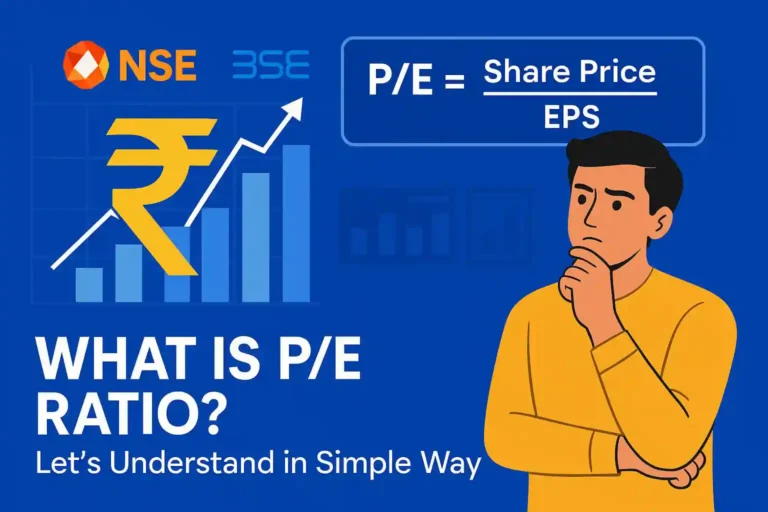If you’re new to investing in the stock market, you might have heard the term “P/E ratio” or “Price-to-Earnings ratio.” But what does it actually mean? And why do experts say it’s important before buying a stock?
In this blog post, we’ll explain the P/E ratio in simple words, show you how to calculate it, and help you understand how to use it to make smarter investment decisions in India.
What is the P/E Ratio?
The P/E ratio is a way to measure how expensive a stock is compared to how much profit the company is making.
Formula:
P/E Ratio = Share Price ÷ Earnings Per Share (EPS)
Let’s take an example:
If a company’s share price is ₹100 and its earnings per share (EPS) is ₹10, then:
P/E Ratio = 100 ÷ 10 = 10
This means investors are willing to pay ₹10 for every ₹1 of the company’s earnings.
Think of it like this: If you’re buying a mobile phone for ₹20,000 and it offers you performance worth ₹2,000 a month, you’re essentially paying 10x the monthly value—just like a P/E of 10.
Why is the P/E Ratio Important for Investors?
The P/E ratio helps you understand if a stock is:
- Overvalued: A high P/E ratio may mean the stock price is too high compared to earnings.
- Undervalued: A low P/E ratio may suggest the stock is cheap and might offer good returns.
You can also use the P/E ratio to compare companies in the same industry. For example, if two banks have different P/E ratios, the one with the lower P/E may offer more value—if other factors are the same.
But remember: a high P/E could also mean the company is expected to grow quickly. So, always look at the full picture.
There are mainly two types:
- Trailing P/E: Based on past 12 months’ earnings (commonly used in India).
- Forward P/E: Based on future earnings estimates.
Most Indian stock market websites like NSE, BSE show the trailing P/E ratio.
What is a Good P/E Ratio?
There’s no fixed number that makes a P/E ratio good or bad—it depends on the industry.
Here are some average P/E ratios by sector in India (as of recent data):
| Sector | Average P/E Ratio |
|---|---|
| Banking | 10–15 |
| IT/Technology | 20–30 |
| FMCG | 30–50 |
| Auto | 12–18 |
- A higher P/E might mean strong future growth (like in tech or FMCG).
- A lower P/E might mean the stock is undervalued—or there may be risks.
Always compare the P/E ratio with industry peers, not just on its own.
Limitations of P/E Ratio
The P/E ratio is useful, but it’s not perfect. Here are a few things to keep in mind:
- Earnings can be manipulated or temporarily high/low.
- Debt levels are not reflected in the P/E ratio.
- A low P/E could also mean poor future prospects.
That’s why smart investors also look at other ratios like PEG ratio, ROE, or Debt-to-Equity.
Conclusion
The P/E ratio is a simple but powerful tool for evaluating a stock’s value. It tells you how much you’re paying for each rupee the company earns. But remember—it’s just one part of the bigger picture.
Before you invest in any stock:
- Check its P/E ratio.
- Compare it with industry peers.
- Understand why the P/E is high or low.

